Home
> Progressions
> Leading
Tone Chord
Now there's just one more chord to add. We'll have then laid the foundations we need to truly experiment with our own songwriting ideas. What you've learned so far is actually quite in-depth as far as music theory goes and, like I've said before, much of the most loved music out there exclusively uses movements within the scale we've learned.
The vii chord is often referred to as a "leading chord" or "leading tone chord", because of its position in relation to the tonic and how it naturally leads on to the tonic (a resolution). A single note being played in this position is simply called a "leading tone", so when we build a chord on this degree we get a leading tone chord.
There are two things that make the vii chord a leading chord...
1) It lies one semitone (half step) down from the tonic.
2) It is naturally a diminished chord and often resolves (or "leads to") to the tonic.
Let's look at that first point now on the fretboard.
The first diagram shows us the root note positions (degrees) of the chords in our scale with the tonic chord root note on the low E string...
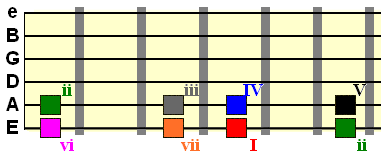
Remember this relationship is movable and relative to the tonic chord's position (which also defines the parent key of a progression).
Now with the tonic chord root on the A string...
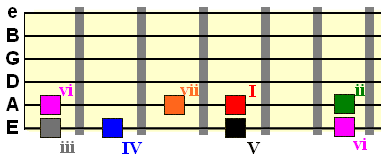
So as you can see, the leading tone chord root note lies just a half step (equivalent to one fret) down from the tonic. This is exactly how the 7th note of the major scale is positioned in relation to the 1st note. Hopefully you'll remember from the first few parts that this chord scale we're building is based on the intervals of the major scale!
The only difference is we're building chords at each interval as opposed to just using single notes.
So what chord do we build on that vii root note? See point 2 above - a diminished chord.
I cover diminished guitar chords in their own lesson, but let's look at some examples to get a flavour of how the diminished vii resolves to the major I tonic.
vi - vii - I - click to hear
Listen to how the diminished vii leading chord naturally resolves to the tonic "home" chord. It just sounds right.
You could also use it as a link between the IV and I chords as a "step up" to the tonic...
IV - vii - I - click to hear
You could also link from the V chord (in the above example that would be G major or G7).
Many theorists and composers consider the leading vii as a natural substitute for the dominant V chord as it is simply the V chord built from its major 3rd tone and therefore shares much of its function.
And remember, this can work anywhere on the fretboard, using barre and movable chord shapes like in the example below...
ii - vii - I - click to hear
That was a good example of how the leading tone vii can replace the dominant V tension chord (as ii V is a typical resolving sequence).
The diminished 7th makes the vii even more tense! It gives it a rather dark and unsettling feel. Think of it as the regular diminished chord's evil twin brother (or... something).
vi - vii - I - click to hear
And don't forget the diminished 7th chord shape on the low E string (requires a barred index finger)...
ii - vii - I - vi - click to hear
The more you experiment with different chord combinations, the more you'll train your ear to know when a particular sound is needed in your songs. For example, you'll be sat there writing a song and you'll hear that "diminished vii sound" in your head as one of your options. That's the stage you ideally need to be at, and where you will be if you keep at it.
We'll revisit diminished chords another time as they can be used in ways other than what we've seen here.
If you've been through the entire series...
From just the 7 chords and the variations we learned in the chord progressions section, thousands of songs, well known and not so well known, have been written over the past decades alone.
But you may or may not know that so far we've only been creating major key progressions (progressions with a major I tonic), so we'll need to look at minor key progressions at some point. Don't worry, minor key progressions make use of exactly the same scale we've learned. We'll come to it later.
The Leading Tone Chord in Chord Progressions
Over the past lessons, we've been building the diatonic chord scale as a foundation for our songwriting.Now there's just one more chord to add. We'll have then laid the foundations we need to truly experiment with our own songwriting ideas. What you've learned so far is actually quite in-depth as far as music theory goes and, like I've said before, much of the most loved music out there exclusively uses movements within the scale we've learned.
The leading tone vii chord
This is the 7th (hence the numeral vii) degree chord in the scale and immediately precedes the tonic (I) by one half step/semitone, from which the scale repeats again.The vii chord is often referred to as a "leading chord" or "leading tone chord", because of its position in relation to the tonic and how it naturally leads on to the tonic (a resolution). A single note being played in this position is simply called a "leading tone", so when we build a chord on this degree we get a leading tone chord.
There are two things that make the vii chord a leading chord...
1) It lies one semitone (half step) down from the tonic.
2) It is naturally a diminished chord and often resolves (or "leads to") to the tonic.
Let's look at that first point now on the fretboard.
The first diagram shows us the root note positions (degrees) of the chords in our scale with the tonic chord root note on the low E string...

Remember this relationship is movable and relative to the tonic chord's position (which also defines the parent key of a progression).
Now with the tonic chord root on the A string...

So as you can see, the leading tone chord root note lies just a half step (equivalent to one fret) down from the tonic. This is exactly how the 7th note of the major scale is positioned in relation to the 1st note. Hopefully you'll remember from the first few parts that this chord scale we're building is based on the intervals of the major scale!
1
W 2
W
3
H
4
W 5
W 6
W 7
H 1
The only difference is we're building chords at each interval as opposed to just using single notes.
So what chord do we build on that vii root note? See point 2 above - a diminished chord.
I cover diminished guitar chords in their own lesson, but let's look at some examples to get a flavour of how the diminished vii resolves to the major I tonic.
The diminished vii link
Diminished chords sound unstable or unresolved so they're most commonly used as links between two more stable chords in a progression. When that diminished chord is in the leading vii position, we get a very natural resolution. Starting in the key of C major...vi - vii - I - click to hear
vi - A
minor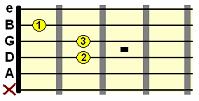
|
vii - B
diminished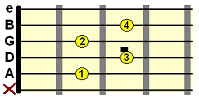 |
I - C major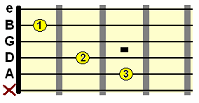 |
Listen to how the diminished vii leading chord naturally resolves to the tonic "home" chord. It just sounds right.
You could also use it as a link between the IV and I chords as a "step up" to the tonic...
IV - vii - I - click to hear
IV - F
major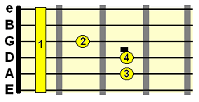 |
vii - B
diminished |
I - C major |
You could also link from the V chord (in the above example that would be G major or G7).
Many theorists and composers consider the leading vii as a natural substitute for the dominant V chord as it is simply the V chord built from its major 3rd tone and therefore shares much of its function.
And remember, this can work anywhere on the fretboard, using barre and movable chord shapes like in the example below...
ii - vii - I - click to hear
ii - F
minor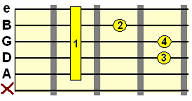 Fret 8 |
vii - D
diminished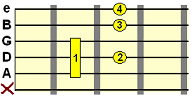 Fret 5 |
I - Eb
major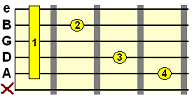 Fret 6 |
That was a good example of how the leading tone vii can replace the dominant V tension chord (as ii V is a typical resolving sequence).
Diminished 7th leading note chord
So as you can see/hear, the vii diminished chord has a very specific and rather limited role, but we can enhance that chord, just as we've done with the other chords in the scale in past lessons.The diminished 7th makes the vii even more tense! It gives it a rather dark and unsettling feel. Think of it as the regular diminished chord's evil twin brother (or... something).
vi - vii - I - click to hear
vi - A
minor
|
vii -
Bdim7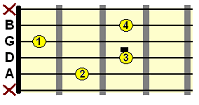 |
I - C major |
And don't forget the diminished 7th chord shape on the low E string (requires a barred index finger)...
ii - vii - I - vi - click to hear
ii - C
minor Fret 3 |
vii -
Adim7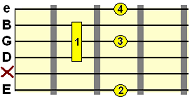 Fret 5 |
I - Bb
major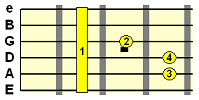 Fret 6 |
vi - G
minor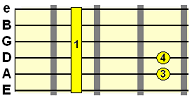 Fret 3 |
The more you experiment with different chord combinations, the more you'll train your ear to know when a particular sound is needed in your songs. For example, you'll be sat there writing a song and you'll hear that "diminished vii sound" in your head as one of your options. That's the stage you ideally need to be at, and where you will be if you keep at it.
We'll revisit diminished chords another time as they can be used in ways other than what we've seen here.
If you've been through the entire series...
From just the 7 chords and the variations we learned in the chord progressions section, thousands of songs, well known and not so well known, have been written over the past decades alone.
But you may or may not know that so far we've only been creating major key progressions (progressions with a major I tonic), so we'll need to look at minor key progressions at some point. Don't worry, minor key progressions make use of exactly the same scale we've learned. We'll come to it later.
| |
Tweet |
Stay updated and learn more
Sign up to the newsletter for updates and grab your free Uncommon Chords book
Sign up to the newsletter for updates and grab your free Uncommon Chords book
Main Guitar Chord Progressions Section








